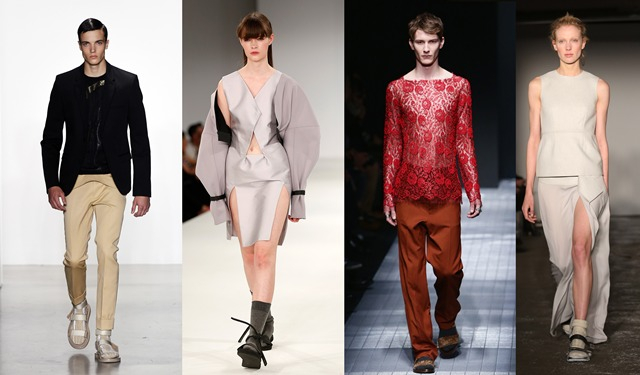
A quirky aspect of the German modegeschmack (fashion sense) was highlighted this year in seemingly unrelated incidents: it was observed on catwalks in New York, Paris and beyond, model Kylie Jenner showcased it in an Instagram video, and British Labour Party leader Jeremy Corbyn wore it for official pictures.
In each instance, fashion bloggers and magazines were quick and choral in attributing the unlikely combination of socks worn with sandals as a German origination — and predilection. There was also some praise: MTV UK reported that Kylie “demonstrates that socks and sandals are, in fact, 100 per cent cool”.
“If King Kylie’s done it, then it it’s obviously going to be the next biggest trend.”
Hardly anyone explained that the hitherto abhorrent but increasingly admired penchant for socks and sandals probably pays homage to one of Germany’s most enduring brands, Birkenstock. While the hardy cork-and-rubber sandal barely qualifies as a fashion statement, it has stayed in fashion since the early 1960s.
Enduring brands
In essence, this defines the subtlety and longevity of the German fashion industry. Hardly anyone considers the country as a global fashion capital. But mention the names and brands, their years of existence and steady success, and it is certain to draw collective awe.
The best examples are Hugo Boss, the Metzingen-based luxury fashion house established in 1924 by Hugo Boss; Gerry Weber International, the Halle-headquartered women’s clothing firm founded in 1973 by Gerhard Weber and Udo Hardieck; and Escada, which was founded in 1978 by Margaretha and Wolfgang Ley in Munich.
Adidas and Puma are two of the world’s best-known brands, but less known is the fact that they were established by warring brothers Adolf and Rudolf Dassler. Adolf launched Adidas in 1949, while Rudolf retained Puma; both companies are still located where they started — in the Bavarian town of Herzogenaurach on opposite sides of the river Aurach.
Germany’s most famous designer is undoubtedly Karl Lagerfeld, who at 82 is head designer and creative director of fashion houses Chanel, Fendi and his eponymous label. Among his contemporaries, 70-year-old Wolfgang Joop is founder of couture label Wunderkind and fashion and cosmetics company JOOP! while 72-year-old Heidemarie Jiline Sander is behind the house Jil Sander. The younger brigade includes Philipp Patrick Plein and Michael Michalsky.
The reality fashion contest Germany’s Next Topmodel is fittingly hosted by German supermodel Heidi Klum. And when arguably Germany’s most famous face, Claudia Schiffer, unveiled her new collection for luxury cashmere label Tse in August she told Vogue that cashmere holds special sentiment because she grew up borrowing it from her parents’ collection. “I still have one from my father, which still looks new because it’s so luxurious,” she said of the line, inspired by her heritage.
Iconic fashion photographer Helmut Newton, meanwhile, was born in Germany, and The New York Times obituary called him “the most powerful and most copied fashion photographer of the 20th century”.
Brisk business as usual
Despite being the second-largest textile importer in the world, the country has experienced an increasing demand for textiles and clothing in recent years, according to German business portal iXPOS.de. “In 2013, Germany’s textile imports reached €36.2 billion [Dh145.4 billion] and exports touched €24 billion, with clothing comprising 40 per cent and textiles 60 per cent of the total turnover that year.
“The structural change during the past decades has transformed the national textile industry from low-tech manufacturing into an innovative high-tech sector,” says iXPOS on the new focus area of technical textiles. “Today the German textile industry is the global market leader for technical textiles with a market share of 45 per cent.”
In May, when Germany won four of eight awards at the Techtextil trade fair in Frankfurt, business information firm Textiles Intelligence commented that German innovation was a key driving force for the global technical textile industry. “Overall, the German technical textile industry generated a turnover of €2.1 billion in 2014 while the turnover of non-wovens reached €1.5 billion,” says the industry authority.
“Together, these two sectors accounted for 36 per cent of the €10 billion generated in turnover by the German textile industry as a whole.”
Every January and July Germany shows off its upcoming collections at the increasingly respected Berlin Fashion Week, and among the de rigueur trade fairs, the Bread and Butter Show stands out for its efforts in showcasing everyday clothing and street wear. Such is its popularity that Barcelona and Seoul editions have been added to its line-up.
And don’t be surprised to see socks and sandals sashay down their catwalks.


